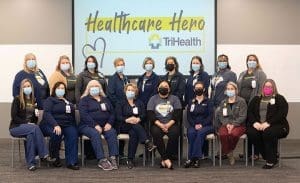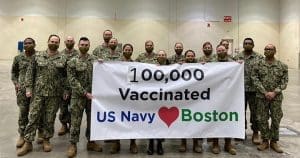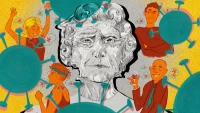We’ve entered the third year of a global pandemic combined with increasing staff shortages, and nurses continue to demonstrate their fortitude, compassion, and professionalism. This year’s All Pro Nursing Team Award submissions proved that point. Over 40 teams shared their stories, projects, successes, and plans for the future. We asked them to describe a successful project (including its impact on patient care or the work environment) and to explain how they’re incorporating lessons learned from the pandemic in anticipation of future crises. Projects ranged from COVID-19 testing and vaccination initiatives to unit reorganization to meet patient surges, clinical ladders to promote professional growth, and nurse wellness programs to enhance nurse physical and mental health.
What stood out among the winning teams was their ability to build on their important work in the midst of a global pandemic. Rather than narrowing their focus to the essentials (understandable given the circumstances), these teams innovated and created new processes and systems to support their colleagues, enhance care, improve outcomes, and advocate for patients.
The staff at American Nurse Journal salutes nurses around the world for their dedication to excellent patient care and compassion for their colleagues. Your work inspires us. Thank you to all the teams that took the time to submit their stories and congratulations to this year’s All Pro Nursing Team Award winners.
Julie Cullen is the managing editor of American Nurse Journal.
Winner
Mercy Medical Center Emergency Department
 While hospitals across the country continue to experience nursing shortages, Mercy Medical Center in Baltimore, MD, the winner of this year’s All Pro Nursing Team Award, took ongoing steps to address its reduced emergency department (ED) staff. As described by Grace Stumbroski, BSN, RN, interim co-manager of the ED, “By the beginning of 2021, we had 10 vacancies, exhausted staff, and no sign of relief. We knew we had to create something unique and innovative to keep our patients safe and our team stabilized and satisfied. To this end, we developed the ProjectED initiative, with the goal of retaining staff through a multi-phased approach.” The project focused on three elements identified by the team as important: increased recognition, growth opportunities, and improved working environment.
While hospitals across the country continue to experience nursing shortages, Mercy Medical Center in Baltimore, MD, the winner of this year’s All Pro Nursing Team Award, took ongoing steps to address its reduced emergency department (ED) staff. As described by Grace Stumbroski, BSN, RN, interim co-manager of the ED, “By the beginning of 2021, we had 10 vacancies, exhausted staff, and no sign of relief. We knew we had to create something unique and innovative to keep our patients safe and our team stabilized and satisfied. To this end, we developed the ProjectED initiative, with the goal of retaining staff through a multi-phased approach.” The project focused on three elements identified by the team as important: increased recognition, growth opportunities, and improved working environment.
Increased recognition
The organization’s current ladder saw only three nurses advance, so the ED team created a ladder focused on emergency nursing skills (triage, competence in more than one patient population). After launching the new ladder in late summer of 2021, two nurses have been promoted and two more are working on their portfolios. “Even more exciting is that the nurses are working on projects and initiatives that mean something to them,” said Stumbroski.
Growth opportunities
Similar to most new graduate nurses around the country, those starting their first job in the Mercy ED had limited clinical experience because of the pandemic. With six new graduates starting in the ED in September 2021, the department created nine biweekly hands-on learning sessions related to various topics, including emergency airway management. “The new nurses loved these sessions,” said Stumbroski. “They felt like they had a safe place to ask questions and express concerns.” Each new graduate was paired with a primary and secondary preceptor. Weekly meetings provided opportunities to review achievements, goals for the next week, and areas for additional focus.
Improved working environment
ED staff identified additional supplies as their top need. Among the many issues resolved in meetings between nurses and leadership were additional Mobilab printers on the unit, computers on wheels, and a plan to remove nonfunctioning computers. Discussions with bio-med led to hiring an ED-specific equipment technician to troubleshoot issues and manage supply inventory.
Outcomes
Currently, the Mercy Medical Center ED has four nurses on the clinical ladder and two preparing to submit their portfolios. The department has only four vacancies, a waiting list of new graduates ready to join the team, and four nurse externs hired for summer 2022. All of the new graduates who started in 2021 have passed orientation and are moving toward growth opportunities. “Overall, the unit’s pulse is positive,” said Stumbroski. “Morale is much better. In fact, one nurse who went to agency nursing has already asked to return to Mercy.”
Stumbroski shared four lessons she and her team have learned during the pandemic that they can apply to future crises: have fun and spark joy, continue to grow and learn, teamwork makes the dream work, and this too shall pass. “We believe it’s essential not to lose sight of the mission and vision of the unit and organization,” explained Stumbroski. “Getting caught up in the negative aspects of a crisis brings down morale and leaves people feeling helpless. Having a focus, like ProjectED, helped minimize the focus primarily being on the pandemic.”
First Runner-Up
TriHealth Corporate Nursing Administration and Corporate Clinical Education
 The 19 professionals on this team, which provides support to the healthcare system’s direct care nurses, developed three projects during the pandemic that went beyond their regular duties: Helping Hands Program, Staffing Models, and COVID-19 Information Sharing.
The 19 professionals on this team, which provides support to the healthcare system’s direct care nurses, developed three projects during the pandemic that went beyond their regular duties: Helping Hands Program, Staffing Models, and COVID-19 Information Sharing.
Helping Hands allowed nurses from non-bed roles to provide acute care support. The team created a sign-up process, assigned nurses as appropriate, provided tip sheets and orientation, and communicated incentives. A concierge component allowed non-nurses to serve as runners, staff temperature stations, and assist with other tasks that don’t require a nursing license.
Staffing Models allowed for an experienced nurse to oversee a team of nurses providing care for a group of patients. Nurses who had been away from direct care offered support by completing tasks such as bathing, turning, administering medications, and answering call lights. To reduce time in the classroom, provide social distancing, and fast track onboarding, the education team added virtual learning.
The team’s COVID-19 Information Sharing project included a series of animated educational videos to address nurses concerns about the COVID-19 vaccines. Before the videos were shared, only 38% of RNs responding to a survey said they would definitely receive a vaccine. After the videos, 87% of the system’s nurses opted to receive the COVID-19 vaccine. You can read more about this project here.
Second Runner-Up
Naval Medical Center Portsmouth Team America
 Within 96 hours of activation, the Defense Security Cooperation Agency 1.1 (Team America)—including 15 active duty nurses and 128 hospital corpsmen (medics)—deployed to support community vaccination efforts in Boston, MA. When the team arrived at the Type 1 Community Vaccination Center located in the Hynes Convention Center, the Federal Emergency Management Agency and contracted healthcare providers were delivering approximately 1,000 vaccinations per day (the center was designed to deliver 6,000 per day). With support from Team America, the center was able to sustain 7-day-per-week operations to deliver more than 7,000 vaccinations each day. This collaborative effort delivered 252,486 vaccines within the first 36 days and ultimately administered over 300,000.
Within 96 hours of activation, the Defense Security Cooperation Agency 1.1 (Team America)—including 15 active duty nurses and 128 hospital corpsmen (medics)—deployed to support community vaccination efforts in Boston, MA. When the team arrived at the Type 1 Community Vaccination Center located in the Hynes Convention Center, the Federal Emergency Management Agency and contracted healthcare providers were delivering approximately 1,000 vaccinations per day (the center was designed to deliver 6,000 per day). With support from Team America, the center was able to sustain 7-day-per-week operations to deliver more than 7,000 vaccinations each day. This collaborative effort delivered 252,486 vaccines within the first 36 days and ultimately administered over 300,000.
The team’s senior nurse leaders provided daily site management and creative staffing models to increase vaccination capabilities by 75%. Team America’s Vaccination Preparation Team assimilated into the existing civilian workforce to help accurately prepare and track vaccines, which led to over 7,200 daily vaccines (an average rate of 700 doses per hour). Using an innovative electronic vaccine tracker, the team achieved real-time awareness of prepared vaccine doses, leading to zero wasted doses and maximum vaccine use.
Of particular note, this diverse team of 15 nurses had never worked together before. They came from different clinical specialties and had varying levels of nursing experience. Their adaptability allowed them to quickly become a team focused on the mission.
Third Runner-Up
Emory Healthcare PLAN Council
 Rather than a clinical ladder that nurses can climb in only one direction, Emory Healthcare created the Professional Lattice for Advancement in Nursing (PLAN). The goal is to allow nurses to advance in all directions and across three professional tracks—education, clinical, or leadership. The PLAN Council includes clinical nurses who represent all system entities, practice specialties, and practice settings. It’s supported by an executive sponsor and other nurse leaders, but clinical nurses make all PLAN decisions.
Rather than a clinical ladder that nurses can climb in only one direction, Emory Healthcare created the Professional Lattice for Advancement in Nursing (PLAN). The goal is to allow nurses to advance in all directions and across three professional tracks—education, clinical, or leadership. The PLAN Council includes clinical nurses who represent all system entities, practice specialties, and practice settings. It’s supported by an executive sponsor and other nurse leaders, but clinical nurses make all PLAN decisions.
At the beginning of the pandemic, PLAN Council work was placed on hold, but the members asked to resume system-level meetings. The executive sponsor and council members recognized the value of their work and collaborated with senior nursing leadership for approval to continue supporting nurses. They resumed their work just 2 months after the pandemic began.
To address factors related to the pandemic, the council streamlined their processes to reduce the number of council members (while still maintaining representation) and the time needed to conduct business. Meetings became virtual and actually saved the Emory system $8,580 each month. Because of the council’s advocacy, 221 nurses advanced in the PLAN during 2020. And despite the stress associated with the pandemic, nursing engagement in the PLAN increased. In addition, the council updated the PLAN to give nurses more opportunities for professional development, advancement, and increased compensation.
Honorable Mention
Edward Hospital Pulmonary Medicine Unit
 In 2016, Edward Hospital received its first Joint Commission Disease Specific Certification for Pneumonia and Chronic Obstructive Pulmonary Disease (COPD). It received recertification in 2018. In March 2020, just months before recertification, the first patient diagnosed with COVID-19 was admitted to the pulmonary medical unit (PMU). To care for the increasing numbers of patients, PMU transitioned to the COVID medical unit within just a few weeks. The number of patients diagnosed with pneumonia and COPD continued to climb, forcing them to be relocated to non-pulmonary units. The PMU team didn’t let this affect their quality of care. They soon merged PMU staff members into the non-pulmonary units to serve as resources. In 2021, The Joint Commission completed a site visit and Edward was re-certified. As of February 2022, only six hospitals in the country hold this for pneumonia and 17 for COPD. The team credits its success to effective communication that helped preserve confidence and trust among the staff.
In 2016, Edward Hospital received its first Joint Commission Disease Specific Certification for Pneumonia and Chronic Obstructive Pulmonary Disease (COPD). It received recertification in 2018. In March 2020, just months before recertification, the first patient diagnosed with COVID-19 was admitted to the pulmonary medical unit (PMU). To care for the increasing numbers of patients, PMU transitioned to the COVID medical unit within just a few weeks. The number of patients diagnosed with pneumonia and COPD continued to climb, forcing them to be relocated to non-pulmonary units. The PMU team didn’t let this affect their quality of care. They soon merged PMU staff members into the non-pulmonary units to serve as resources. In 2021, The Joint Commission completed a site visit and Edward was re-certified. As of February 2022, only six hospitals in the country hold this for pneumonia and 17 for COPD. The team credits its success to effective communication that helped preserve confidence and trust among the staff.
Maury Regional Medical Center Palliative Care Team
 Many seriously ill patients enter hospitals without proper documentation related to end of life wishes, resulting in unwanted or unnecessary care. The palliative care team at Maury Regional Medical Center created a quality improvement project to successfully complete a physician orders for scope of treatment (POST) form for all patients who request DNR/DNI. The process includes making an automatic referral to the palliative care team for every patient the hospitalist identifies as DNR/DNI in the electronic health record. In collaboration with the patient and family, the team completes the POST form and delivers it to the hospitalist team to verify and sign. A copy is given to the patient and added to their health record. In addition, the team documents the code status in the patient’s discharge summary. Before this project, the palliative care team averaged 11 POST forms per month. Since March 2020, more than 1,630 forms have been successfully completed.
Many seriously ill patients enter hospitals without proper documentation related to end of life wishes, resulting in unwanted or unnecessary care. The palliative care team at Maury Regional Medical Center created a quality improvement project to successfully complete a physician orders for scope of treatment (POST) form for all patients who request DNR/DNI. The process includes making an automatic referral to the palliative care team for every patient the hospitalist identifies as DNR/DNI in the electronic health record. In collaboration with the patient and family, the team completes the POST form and delivers it to the hospitalist team to verify and sign. A copy is given to the patient and added to their health record. In addition, the team documents the code status in the patient’s discharge summary. Before this project, the palliative care team averaged 11 POST forms per month. Since March 2020, more than 1,630 forms have been successfully completed.
Duke University Hospital HBC Ambulatory Leadership Team
 To ramp up testing for COVID-19 among students, staff, and the community, this team placed a small tent at the service entrance to the clinic to accommodate drive-thru testing. In short order, they added a large drive-thru testing tent in a parking lot of the hospital campus. They now had the ability to test occupants of up to 8 cars simultaneously. The team provided testing 7 days per week, and they eventually reached 850 tests per day. The team then created a community vaccination center at which almost 161,000 people (including children) were vaccinated. The biggest lesson this team has learned from the pandemic is that nothing is impossible and that the impossible can happen quickly when the right people are involved.
To ramp up testing for COVID-19 among students, staff, and the community, this team placed a small tent at the service entrance to the clinic to accommodate drive-thru testing. In short order, they added a large drive-thru testing tent in a parking lot of the hospital campus. They now had the ability to test occupants of up to 8 cars simultaneously. The team provided testing 7 days per week, and they eventually reached 850 tests per day. The team then created a community vaccination center at which almost 161,000 people (including children) were vaccinated. The biggest lesson this team has learned from the pandemic is that nothing is impossible and that the impossible can happen quickly when the right people are involved.
The Ohio State University Buckeye Wellness Innovators
 The Buckeye Wellness Innovators (BWIs) promote university‐wide wellness initiatives and the One University Health and Wellness strategic plan by communicating health and wellness activities to their colleagues (and students where appropriate), encouraging and motivating colleagues to participate in wellness initiatives, enhancing a wellness culture in their units, planning and conducting unit‐specific wellness activities, and collaborating with the Office of the Chief Wellness Officer/Buckeye Wellness, Your Plan for Health, and the OSU Health Plan to promote health and wellness. Currently 573 active faculty and staff serve as BWIs across the university. The program provides a monthly newsletter that identifies specific ways BWIs can support a culture of wellness, offers financial support for BWIs, and conducts bi-monthly webinars. During the pandemic, BWIs have been instrumental in providing wellness services and helping colleagues access mental and emotional health resources.
The Buckeye Wellness Innovators (BWIs) promote university‐wide wellness initiatives and the One University Health and Wellness strategic plan by communicating health and wellness activities to their colleagues (and students where appropriate), encouraging and motivating colleagues to participate in wellness initiatives, enhancing a wellness culture in their units, planning and conducting unit‐specific wellness activities, and collaborating with the Office of the Chief Wellness Officer/Buckeye Wellness, Your Plan for Health, and the OSU Health Plan to promote health and wellness. Currently 573 active faculty and staff serve as BWIs across the university. The program provides a monthly newsletter that identifies specific ways BWIs can support a culture of wellness, offers financial support for BWIs, and conducts bi-monthly webinars. During the pandemic, BWIs have been instrumental in providing wellness services and helping colleagues access mental and emotional health resources.



















1 Comment. Leave new
Thanks for letting us know about the significant and inspiring role these teams are doing. Their actions, as well as the actions of many on the frontlines of care delivery are notable and admirable.